Overview of Massachusetts General Hospital and its Services
VerifiedAdded on 2023/02/01
|8
|1929
|54
AI Summary
This document provides an overview of the Massachusetts General Hospital, including its services and job positions available. It discusses the recruitment and retention processes implemented by the hospital and the strategies for employee evaluations. The document also highlights the importance of employee retention in healthcare organizations.
Contribute Materials
Your contribution can guide someone’s learning journey. Share your
documents today.
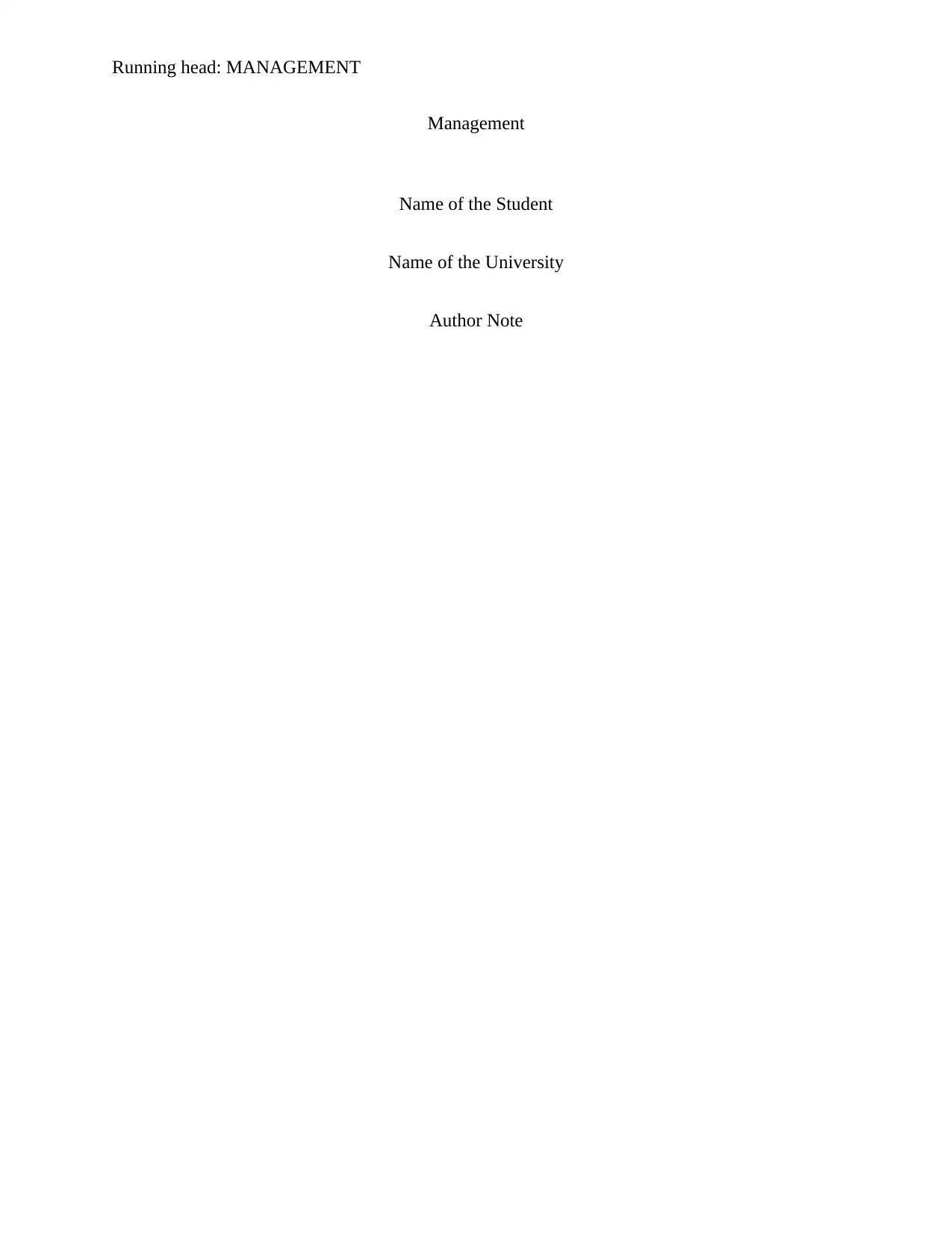
Running head: MANAGEMENT
Management
Name of the Student
Name of the University
Author Note
Management
Name of the Student
Name of the University
Author Note
Secure Best Marks with AI Grader
Need help grading? Try our AI Grader for instant feedback on your assignments.
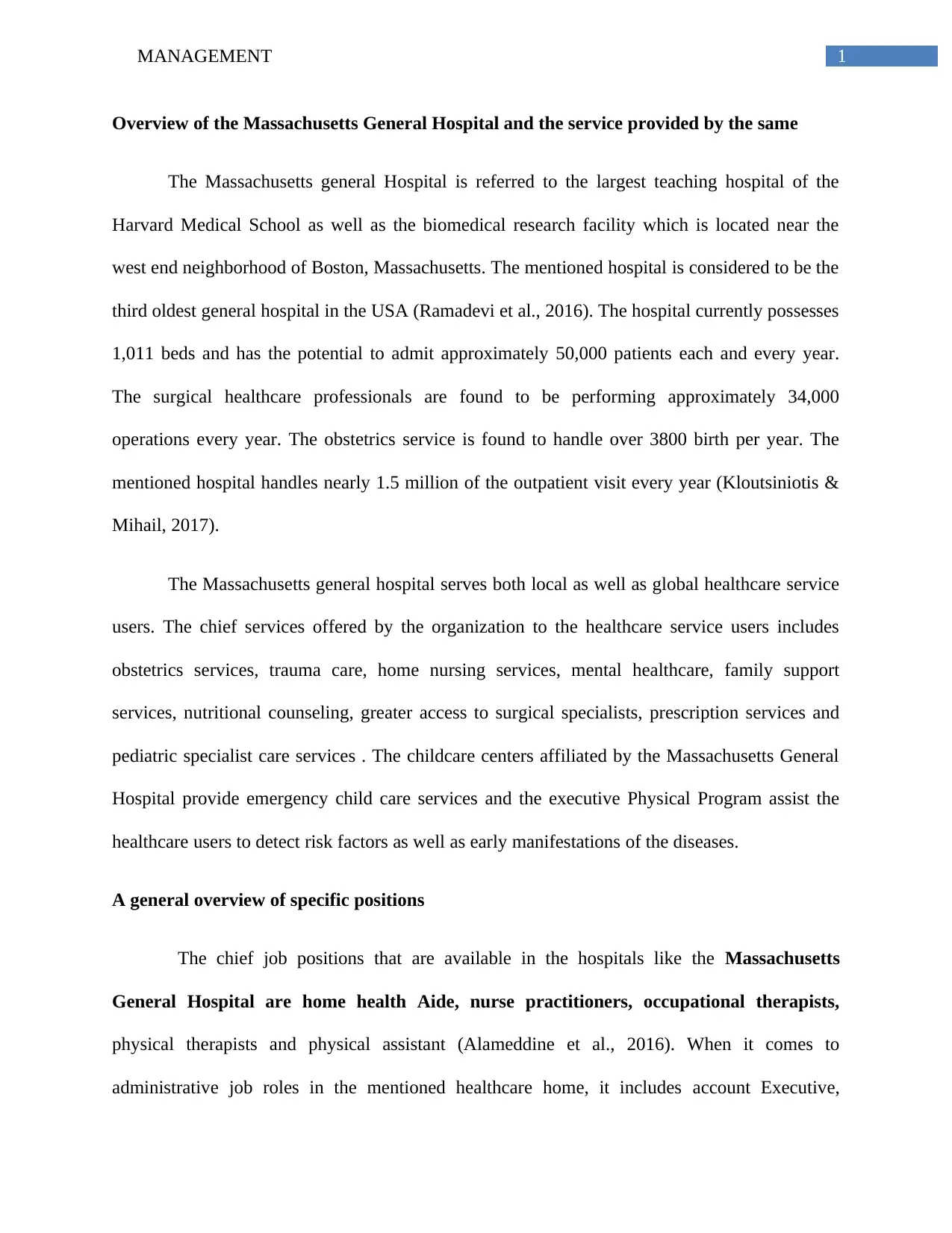
1MANAGEMENT
Overview of the Massachusetts General Hospital and the service provided by the same
The Massachusetts general Hospital is referred to the largest teaching hospital of the
Harvard Medical School as well as the biomedical research facility which is located near the
west end neighborhood of Boston, Massachusetts. The mentioned hospital is considered to be the
third oldest general hospital in the USA (Ramadevi et al., 2016). The hospital currently possesses
1,011 beds and has the potential to admit approximately 50,000 patients each and every year.
The surgical healthcare professionals are found to be performing approximately 34,000
operations every year. The obstetrics service is found to handle over 3800 birth per year. The
mentioned hospital handles nearly 1.5 million of the outpatient visit every year (Kloutsiniotis &
Mihail, 2017).
The Massachusetts general hospital serves both local as well as global healthcare service
users. The chief services offered by the organization to the healthcare service users includes
obstetrics services, trauma care, home nursing services, mental healthcare, family support
services, nutritional counseling, greater access to surgical specialists, prescription services and
pediatric specialist care services . The childcare centers affiliated by the Massachusetts General
Hospital provide emergency child care services and the executive Physical Program assist the
healthcare users to detect risk factors as well as early manifestations of the diseases.
A general overview of specific positions
The chief job positions that are available in the hospitals like the Massachusetts
General Hospital are home health Aide, nurse practitioners, occupational therapists,
physical therapists and physical assistant (Alameddine et al., 2016). When it comes to
administrative job roles in the mentioned healthcare home, it includes account Executive,
Overview of the Massachusetts General Hospital and the service provided by the same
The Massachusetts general Hospital is referred to the largest teaching hospital of the
Harvard Medical School as well as the biomedical research facility which is located near the
west end neighborhood of Boston, Massachusetts. The mentioned hospital is considered to be the
third oldest general hospital in the USA (Ramadevi et al., 2016). The hospital currently possesses
1,011 beds and has the potential to admit approximately 50,000 patients each and every year.
The surgical healthcare professionals are found to be performing approximately 34,000
operations every year. The obstetrics service is found to handle over 3800 birth per year. The
mentioned hospital handles nearly 1.5 million of the outpatient visit every year (Kloutsiniotis &
Mihail, 2017).
The Massachusetts general hospital serves both local as well as global healthcare service
users. The chief services offered by the organization to the healthcare service users includes
obstetrics services, trauma care, home nursing services, mental healthcare, family support
services, nutritional counseling, greater access to surgical specialists, prescription services and
pediatric specialist care services . The childcare centers affiliated by the Massachusetts General
Hospital provide emergency child care services and the executive Physical Program assist the
healthcare users to detect risk factors as well as early manifestations of the diseases.
A general overview of specific positions
The chief job positions that are available in the hospitals like the Massachusetts
General Hospital are home health Aide, nurse practitioners, occupational therapists,
physical therapists and physical assistant (Alameddine et al., 2016). When it comes to
administrative job roles in the mentioned healthcare home, it includes account Executive,
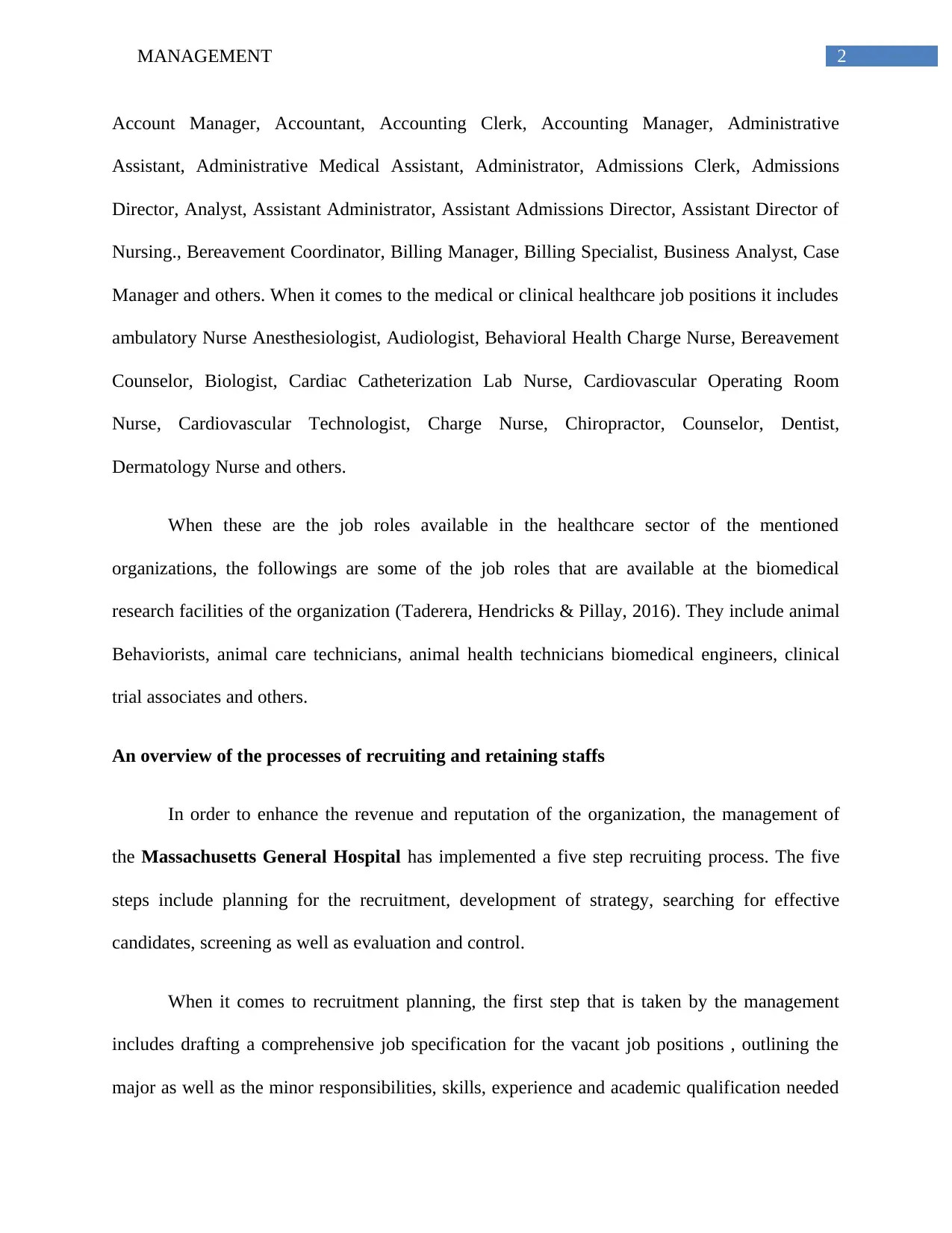
2MANAGEMENT
Account Manager, Accountant, Accounting Clerk, Accounting Manager, Administrative
Assistant, Administrative Medical Assistant, Administrator, Admissions Clerk, Admissions
Director, Analyst, Assistant Administrator, Assistant Admissions Director, Assistant Director of
Nursing., Bereavement Coordinator, Billing Manager, Billing Specialist, Business Analyst, Case
Manager and others. When it comes to the medical or clinical healthcare job positions it includes
ambulatory Nurse Anesthesiologist, Audiologist, Behavioral Health Charge Nurse, Bereavement
Counselor, Biologist, Cardiac Catheterization Lab Nurse, Cardiovascular Operating Room
Nurse, Cardiovascular Technologist, Charge Nurse, Chiropractor, Counselor, Dentist,
Dermatology Nurse and others.
When these are the job roles available in the healthcare sector of the mentioned
organizations, the followings are some of the job roles that are available at the biomedical
research facilities of the organization (Taderera, Hendricks & Pillay, 2016). They include animal
Behaviorists, animal care technicians, animal health technicians biomedical engineers, clinical
trial associates and others.
An overview of the processes of recruiting and retaining staffs
In order to enhance the revenue and reputation of the organization, the management of
the Massachusetts General Hospital has implemented a five step recruiting process. The five
steps include planning for the recruitment, development of strategy, searching for effective
candidates, screening as well as evaluation and control.
When it comes to recruitment planning, the first step that is taken by the management
includes drafting a comprehensive job specification for the vacant job positions , outlining the
major as well as the minor responsibilities, skills, experience and academic qualification needed
Account Manager, Accountant, Accounting Clerk, Accounting Manager, Administrative
Assistant, Administrative Medical Assistant, Administrator, Admissions Clerk, Admissions
Director, Analyst, Assistant Administrator, Assistant Admissions Director, Assistant Director of
Nursing., Bereavement Coordinator, Billing Manager, Billing Specialist, Business Analyst, Case
Manager and others. When it comes to the medical or clinical healthcare job positions it includes
ambulatory Nurse Anesthesiologist, Audiologist, Behavioral Health Charge Nurse, Bereavement
Counselor, Biologist, Cardiac Catheterization Lab Nurse, Cardiovascular Operating Room
Nurse, Cardiovascular Technologist, Charge Nurse, Chiropractor, Counselor, Dentist,
Dermatology Nurse and others.
When these are the job roles available in the healthcare sector of the mentioned
organizations, the followings are some of the job roles that are available at the biomedical
research facilities of the organization (Taderera, Hendricks & Pillay, 2016). They include animal
Behaviorists, animal care technicians, animal health technicians biomedical engineers, clinical
trial associates and others.
An overview of the processes of recruiting and retaining staffs
In order to enhance the revenue and reputation of the organization, the management of
the Massachusetts General Hospital has implemented a five step recruiting process. The five
steps include planning for the recruitment, development of strategy, searching for effective
candidates, screening as well as evaluation and control.
When it comes to recruitment planning, the first step that is taken by the management
includes drafting a comprehensive job specification for the vacant job positions , outlining the
major as well as the minor responsibilities, skills, experience and academic qualification needed
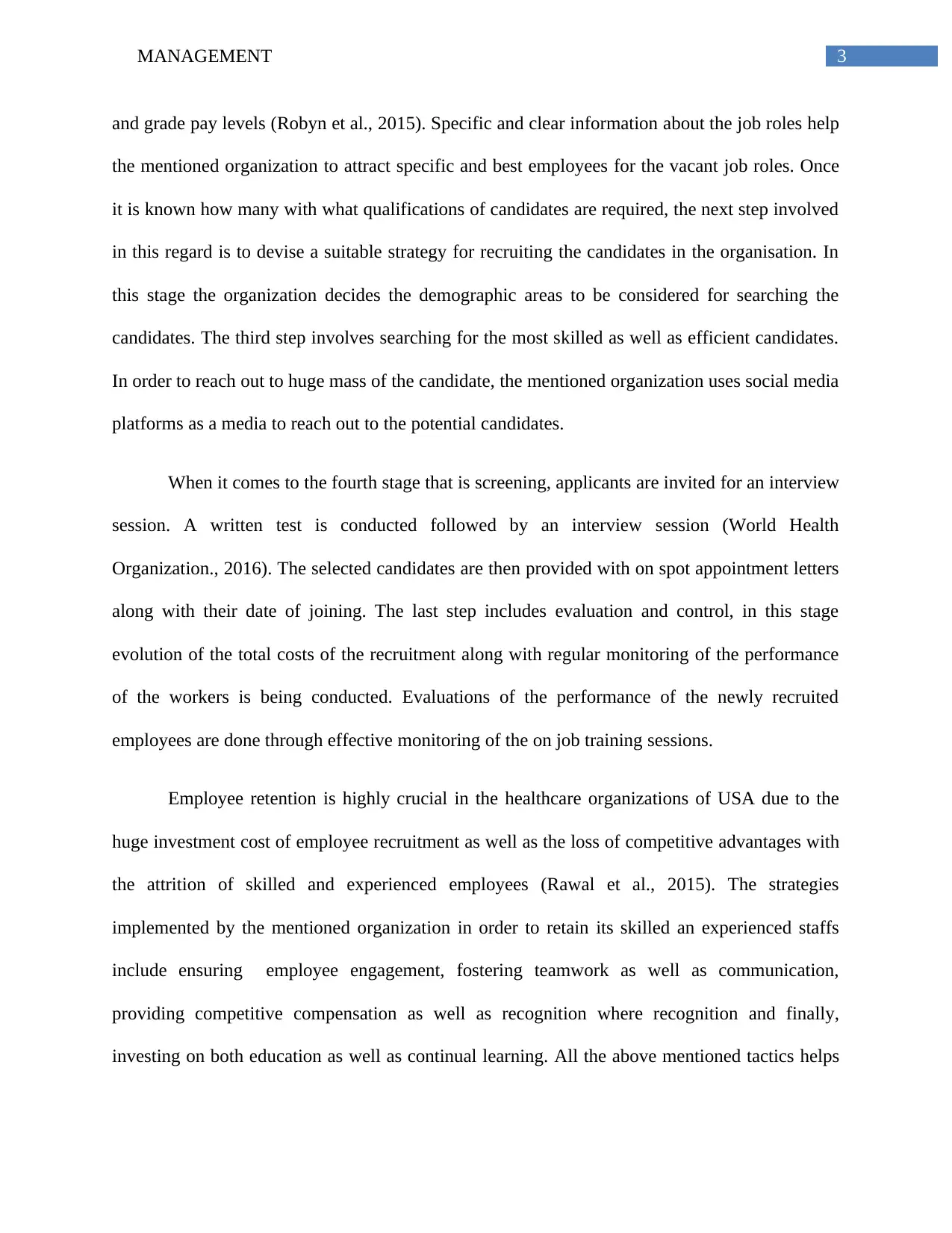
3MANAGEMENT
and grade pay levels (Robyn et al., 2015). Specific and clear information about the job roles help
the mentioned organization to attract specific and best employees for the vacant job roles. Once
it is known how many with what qualifications of candidates are required, the next step involved
in this regard is to devise a suitable strategy for recruiting the candidates in the organisation. In
this stage the organization decides the demographic areas to be considered for searching the
candidates. The third step involves searching for the most skilled as well as efficient candidates.
In order to reach out to huge mass of the candidate, the mentioned organization uses social media
platforms as a media to reach out to the potential candidates.
When it comes to the fourth stage that is screening, applicants are invited for an interview
session. A written test is conducted followed by an interview session (World Health
Organization., 2016). The selected candidates are then provided with on spot appointment letters
along with their date of joining. The last step includes evaluation and control, in this stage
evolution of the total costs of the recruitment along with regular monitoring of the performance
of the workers is being conducted. Evaluations of the performance of the newly recruited
employees are done through effective monitoring of the on job training sessions.
Employee retention is highly crucial in the healthcare organizations of USA due to the
huge investment cost of employee recruitment as well as the loss of competitive advantages with
the attrition of skilled and experienced employees (Rawal et al., 2015). The strategies
implemented by the mentioned organization in order to retain its skilled an experienced staffs
include ensuring employee engagement, fostering teamwork as well as communication,
providing competitive compensation as well as recognition where recognition and finally,
investing on both education as well as continual learning. All the above mentioned tactics helps
and grade pay levels (Robyn et al., 2015). Specific and clear information about the job roles help
the mentioned organization to attract specific and best employees for the vacant job roles. Once
it is known how many with what qualifications of candidates are required, the next step involved
in this regard is to devise a suitable strategy for recruiting the candidates in the organisation. In
this stage the organization decides the demographic areas to be considered for searching the
candidates. The third step involves searching for the most skilled as well as efficient candidates.
In order to reach out to huge mass of the candidate, the mentioned organization uses social media
platforms as a media to reach out to the potential candidates.
When it comes to the fourth stage that is screening, applicants are invited for an interview
session. A written test is conducted followed by an interview session (World Health
Organization., 2016). The selected candidates are then provided with on spot appointment letters
along with their date of joining. The last step includes evaluation and control, in this stage
evolution of the total costs of the recruitment along with regular monitoring of the performance
of the workers is being conducted. Evaluations of the performance of the newly recruited
employees are done through effective monitoring of the on job training sessions.
Employee retention is highly crucial in the healthcare organizations of USA due to the
huge investment cost of employee recruitment as well as the loss of competitive advantages with
the attrition of skilled and experienced employees (Rawal et al., 2015). The strategies
implemented by the mentioned organization in order to retain its skilled an experienced staffs
include ensuring employee engagement, fostering teamwork as well as communication,
providing competitive compensation as well as recognition where recognition and finally,
investing on both education as well as continual learning. All the above mentioned tactics helps
Secure Best Marks with AI Grader
Need help grading? Try our AI Grader for instant feedback on your assignments.
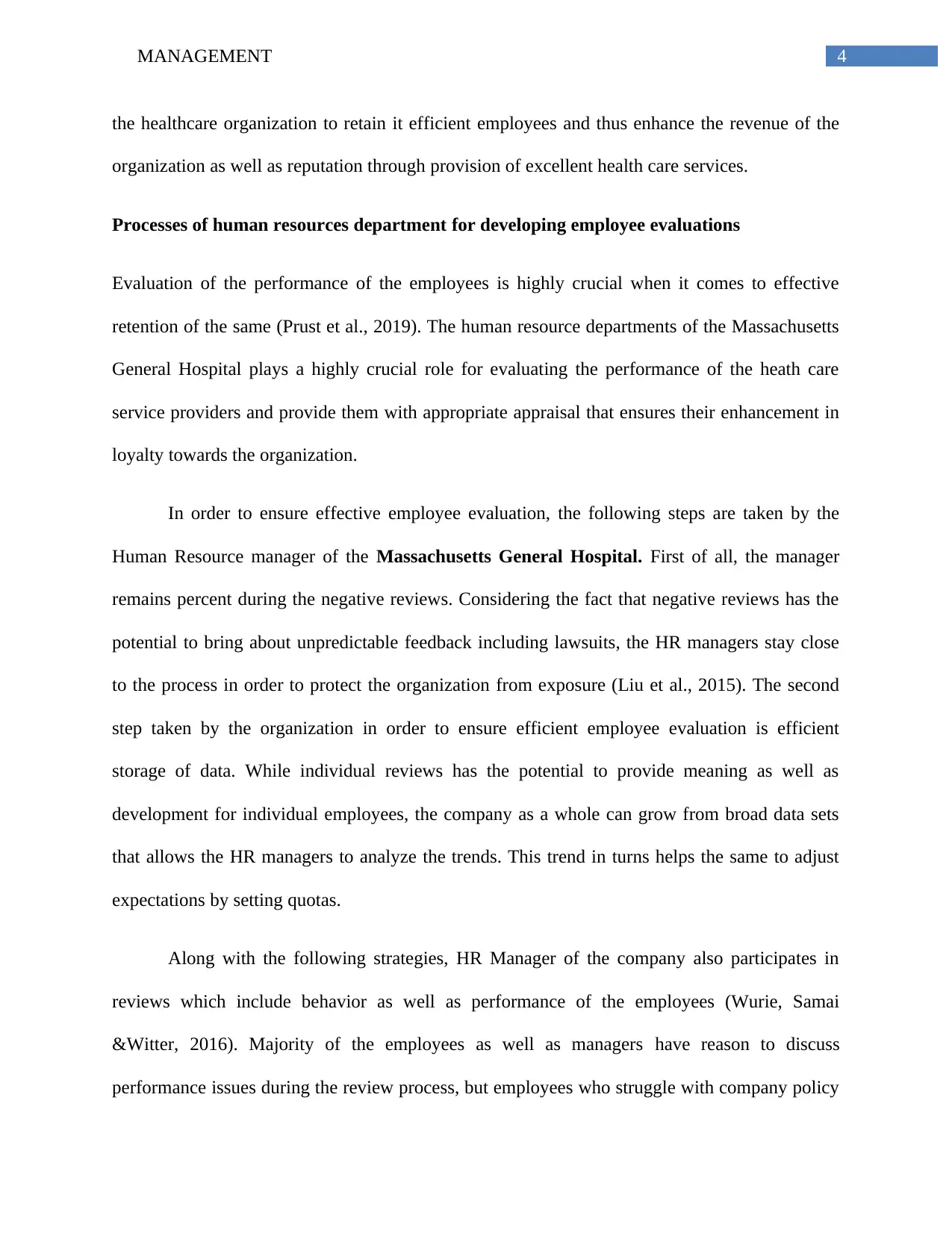
4MANAGEMENT
the healthcare organization to retain it efficient employees and thus enhance the revenue of the
organization as well as reputation through provision of excellent health care services.
Processes of human resources department for developing employee evaluations
Evaluation of the performance of the employees is highly crucial when it comes to effective
retention of the same (Prust et al., 2019). The human resource departments of the Massachusetts
General Hospital plays a highly crucial role for evaluating the performance of the heath care
service providers and provide them with appropriate appraisal that ensures their enhancement in
loyalty towards the organization.
In order to ensure effective employee evaluation, the following steps are taken by the
Human Resource manager of the Massachusetts General Hospital. First of all, the manager
remains percent during the negative reviews. Considering the fact that negative reviews has the
potential to bring about unpredictable feedback including lawsuits, the HR managers stay close
to the process in order to protect the organization from exposure (Liu et al., 2015). The second
step taken by the organization in order to ensure efficient employee evaluation is efficient
storage of data. While individual reviews has the potential to provide meaning as well as
development for individual employees, the company as a whole can grow from broad data sets
that allows the HR managers to analyze the trends. This trend in turns helps the same to adjust
expectations by setting quotas.
Along with the following strategies, HR Manager of the company also participates in
reviews which include behavior as well as performance of the employees (Wurie, Samai
&Witter, 2016). Majority of the employees as well as managers have reason to discuss
performance issues during the review process, but employees who struggle with company policy
the healthcare organization to retain it efficient employees and thus enhance the revenue of the
organization as well as reputation through provision of excellent health care services.
Processes of human resources department for developing employee evaluations
Evaluation of the performance of the employees is highly crucial when it comes to effective
retention of the same (Prust et al., 2019). The human resource departments of the Massachusetts
General Hospital plays a highly crucial role for evaluating the performance of the heath care
service providers and provide them with appropriate appraisal that ensures their enhancement in
loyalty towards the organization.
In order to ensure effective employee evaluation, the following steps are taken by the
Human Resource manager of the Massachusetts General Hospital. First of all, the manager
remains percent during the negative reviews. Considering the fact that negative reviews has the
potential to bring about unpredictable feedback including lawsuits, the HR managers stay close
to the process in order to protect the organization from exposure (Liu et al., 2015). The second
step taken by the organization in order to ensure efficient employee evaluation is efficient
storage of data. While individual reviews has the potential to provide meaning as well as
development for individual employees, the company as a whole can grow from broad data sets
that allows the HR managers to analyze the trends. This trend in turns helps the same to adjust
expectations by setting quotas.
Along with the following strategies, HR Manager of the company also participates in
reviews which include behavior as well as performance of the employees (Wurie, Samai
&Witter, 2016). Majority of the employees as well as managers have reason to discuss
performance issues during the review process, but employees who struggle with company policy
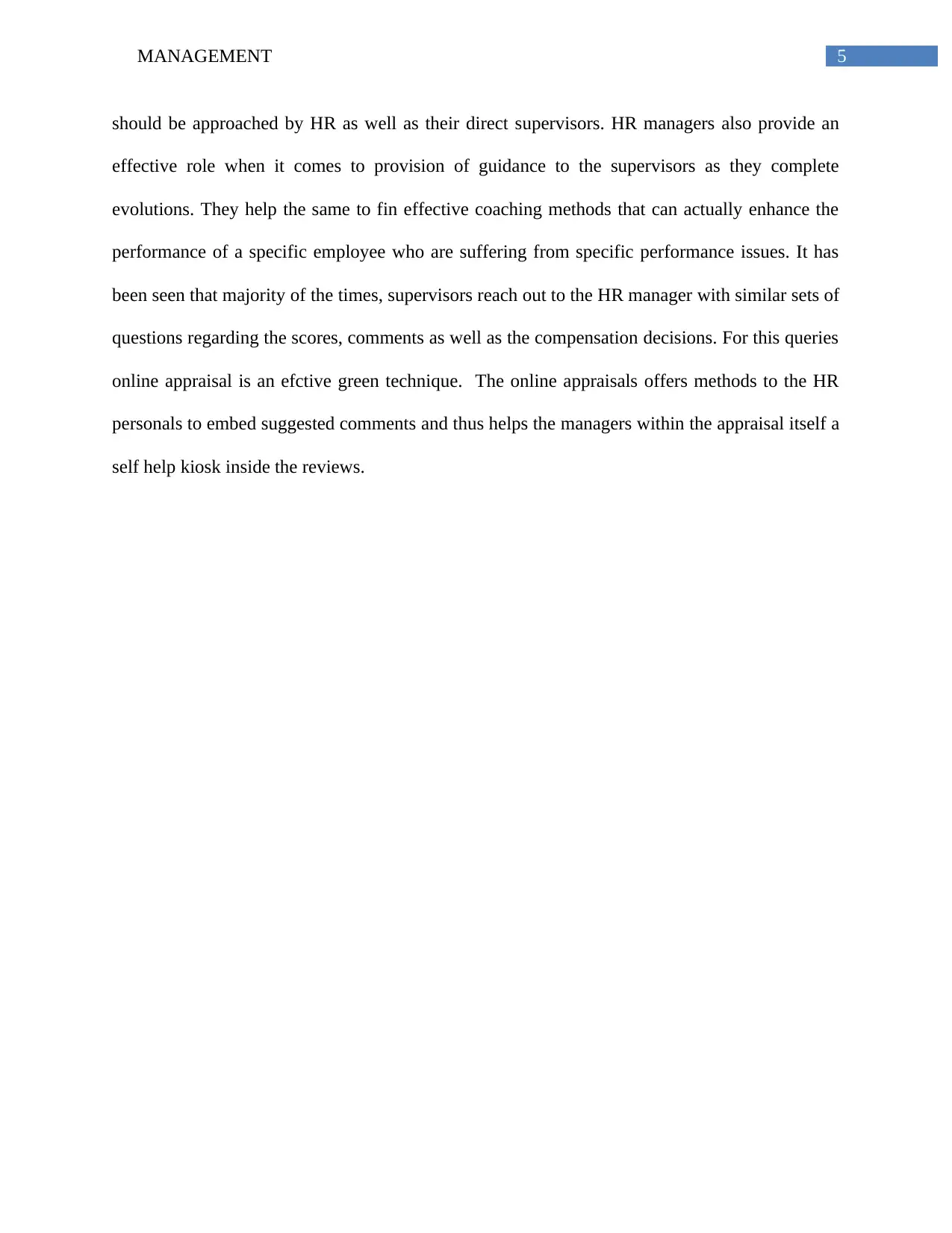
5MANAGEMENT
should be approached by HR as well as their direct supervisors. HR managers also provide an
effective role when it comes to provision of guidance to the supervisors as they complete
evolutions. They help the same to fin effective coaching methods that can actually enhance the
performance of a specific employee who are suffering from specific performance issues. It has
been seen that majority of the times, supervisors reach out to the HR manager with similar sets of
questions regarding the scores, comments as well as the compensation decisions. For this queries
online appraisal is an efctive green technique. The online appraisals offers methods to the HR
personals to embed suggested comments and thus helps the managers within the appraisal itself a
self help kiosk inside the reviews.
should be approached by HR as well as their direct supervisors. HR managers also provide an
effective role when it comes to provision of guidance to the supervisors as they complete
evolutions. They help the same to fin effective coaching methods that can actually enhance the
performance of a specific employee who are suffering from specific performance issues. It has
been seen that majority of the times, supervisors reach out to the HR manager with similar sets of
questions regarding the scores, comments as well as the compensation decisions. For this queries
online appraisal is an efctive green technique. The online appraisals offers methods to the HR
personals to embed suggested comments and thus helps the managers within the appraisal itself a
self help kiosk inside the reviews.
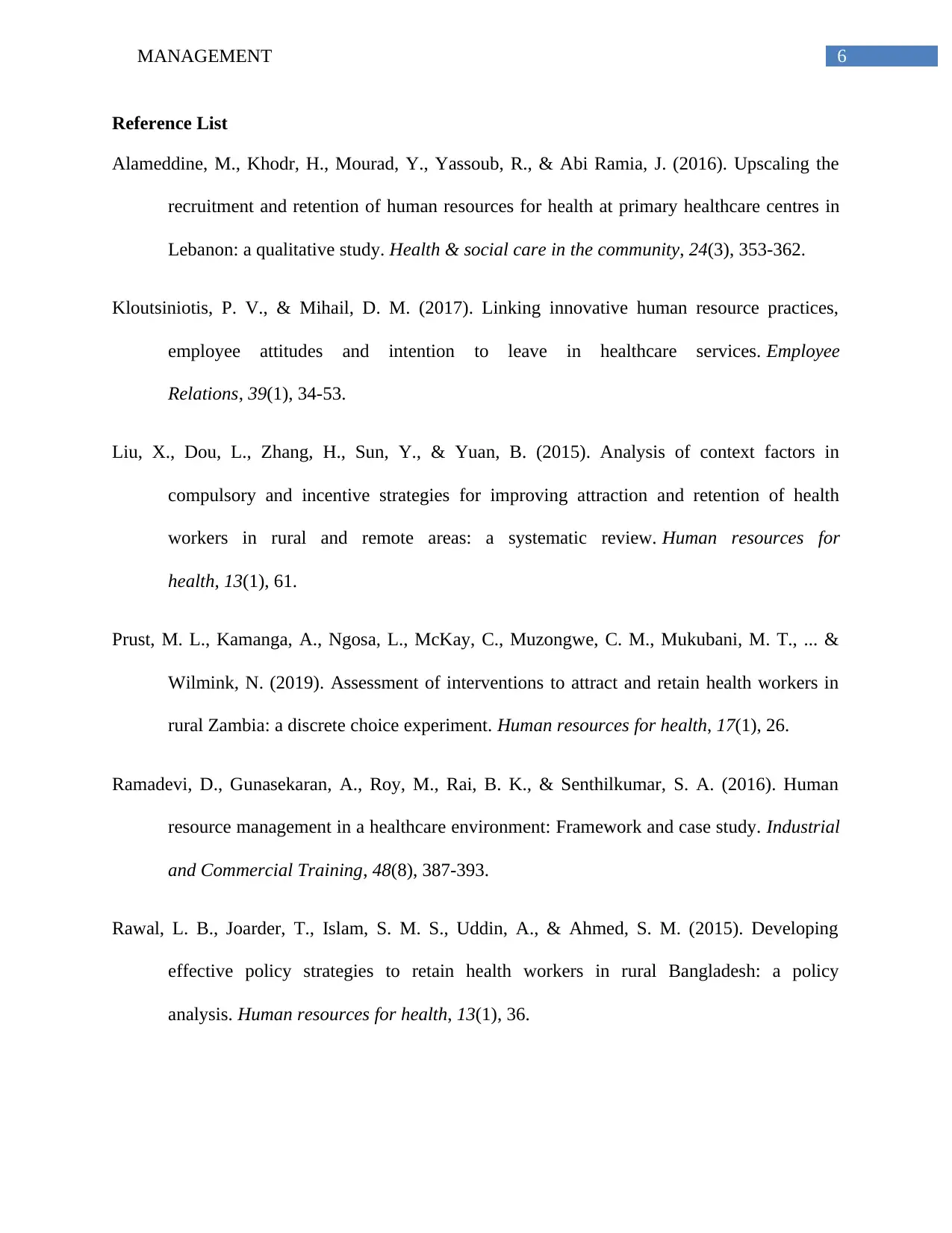
6MANAGEMENT
Reference List
Alameddine, M., Khodr, H., Mourad, Y., Yassoub, R., & Abi Ramia, J. (2016). Upscaling the
recruitment and retention of human resources for health at primary healthcare centres in
Lebanon: a qualitative study. Health & social care in the community, 24(3), 353-362.
Kloutsiniotis, P. V., & Mihail, D. M. (2017). Linking innovative human resource practices,
employee attitudes and intention to leave in healthcare services. Employee
Relations, 39(1), 34-53.
Liu, X., Dou, L., Zhang, H., Sun, Y., & Yuan, B. (2015). Analysis of context factors in
compulsory and incentive strategies for improving attraction and retention of health
workers in rural and remote areas: a systematic review. Human resources for
health, 13(1), 61.
Prust, M. L., Kamanga, A., Ngosa, L., McKay, C., Muzongwe, C. M., Mukubani, M. T., ... &
Wilmink, N. (2019). Assessment of interventions to attract and retain health workers in
rural Zambia: a discrete choice experiment. Human resources for health, 17(1), 26.
Ramadevi, D., Gunasekaran, A., Roy, M., Rai, B. K., & Senthilkumar, S. A. (2016). Human
resource management in a healthcare environment: Framework and case study. Industrial
and Commercial Training, 48(8), 387-393.
Rawal, L. B., Joarder, T., Islam, S. M. S., Uddin, A., & Ahmed, S. M. (2015). Developing
effective policy strategies to retain health workers in rural Bangladesh: a policy
analysis. Human resources for health, 13(1), 36.
Reference List
Alameddine, M., Khodr, H., Mourad, Y., Yassoub, R., & Abi Ramia, J. (2016). Upscaling the
recruitment and retention of human resources for health at primary healthcare centres in
Lebanon: a qualitative study. Health & social care in the community, 24(3), 353-362.
Kloutsiniotis, P. V., & Mihail, D. M. (2017). Linking innovative human resource practices,
employee attitudes and intention to leave in healthcare services. Employee
Relations, 39(1), 34-53.
Liu, X., Dou, L., Zhang, H., Sun, Y., & Yuan, B. (2015). Analysis of context factors in
compulsory and incentive strategies for improving attraction and retention of health
workers in rural and remote areas: a systematic review. Human resources for
health, 13(1), 61.
Prust, M. L., Kamanga, A., Ngosa, L., McKay, C., Muzongwe, C. M., Mukubani, M. T., ... &
Wilmink, N. (2019). Assessment of interventions to attract and retain health workers in
rural Zambia: a discrete choice experiment. Human resources for health, 17(1), 26.
Ramadevi, D., Gunasekaran, A., Roy, M., Rai, B. K., & Senthilkumar, S. A. (2016). Human
resource management in a healthcare environment: Framework and case study. Industrial
and Commercial Training, 48(8), 387-393.
Rawal, L. B., Joarder, T., Islam, S. M. S., Uddin, A., & Ahmed, S. M. (2015). Developing
effective policy strategies to retain health workers in rural Bangladesh: a policy
analysis. Human resources for health, 13(1), 36.
Paraphrase This Document
Need a fresh take? Get an instant paraphrase of this document with our AI Paraphraser

7MANAGEMENT
Robyn, P. J., Shroff, Z., Zang, O. R., Kingue, S., Djienouassi, S., Kouontchou, C., & Sorgho, G.
(2015). Addressing health workforce distribution concerns: a discrete choice experiment
to develop rural retention strategies in Cameroon. International journal of health policy
and management, 4(3), 169.
Taderera, B. H., Hendricks, S., & Pillay, Y. (2016). Health personnel retention strategies in a
peri-urban community: an exploratory study on Epworth, Zimbabwe. Human resources
for health, 14(1), 17.
World Health Organization. (2016). Global strategy on human resources for health: workforce
2030.
Wurie, H. R., Samai, M., & Witter, S. (2016). Retention of health workers in rural Sierra Leone:
findings from life histories. Human resources for health, 14(1), 3.
Robyn, P. J., Shroff, Z., Zang, O. R., Kingue, S., Djienouassi, S., Kouontchou, C., & Sorgho, G.
(2015). Addressing health workforce distribution concerns: a discrete choice experiment
to develop rural retention strategies in Cameroon. International journal of health policy
and management, 4(3), 169.
Taderera, B. H., Hendricks, S., & Pillay, Y. (2016). Health personnel retention strategies in a
peri-urban community: an exploratory study on Epworth, Zimbabwe. Human resources
for health, 14(1), 17.
World Health Organization. (2016). Global strategy on human resources for health: workforce
2030.
Wurie, H. R., Samai, M., & Witter, S. (2016). Retention of health workers in rural Sierra Leone:
findings from life histories. Human resources for health, 14(1), 3.
1 out of 8
Your All-in-One AI-Powered Toolkit for Academic Success.
+13062052269
info@desklib.com
Available 24*7 on WhatsApp / Email
![[object Object]](/_next/static/media/star-bottom.7253800d.svg)
Unlock your academic potential
© 2024 | Zucol Services PVT LTD | All rights reserved.
